
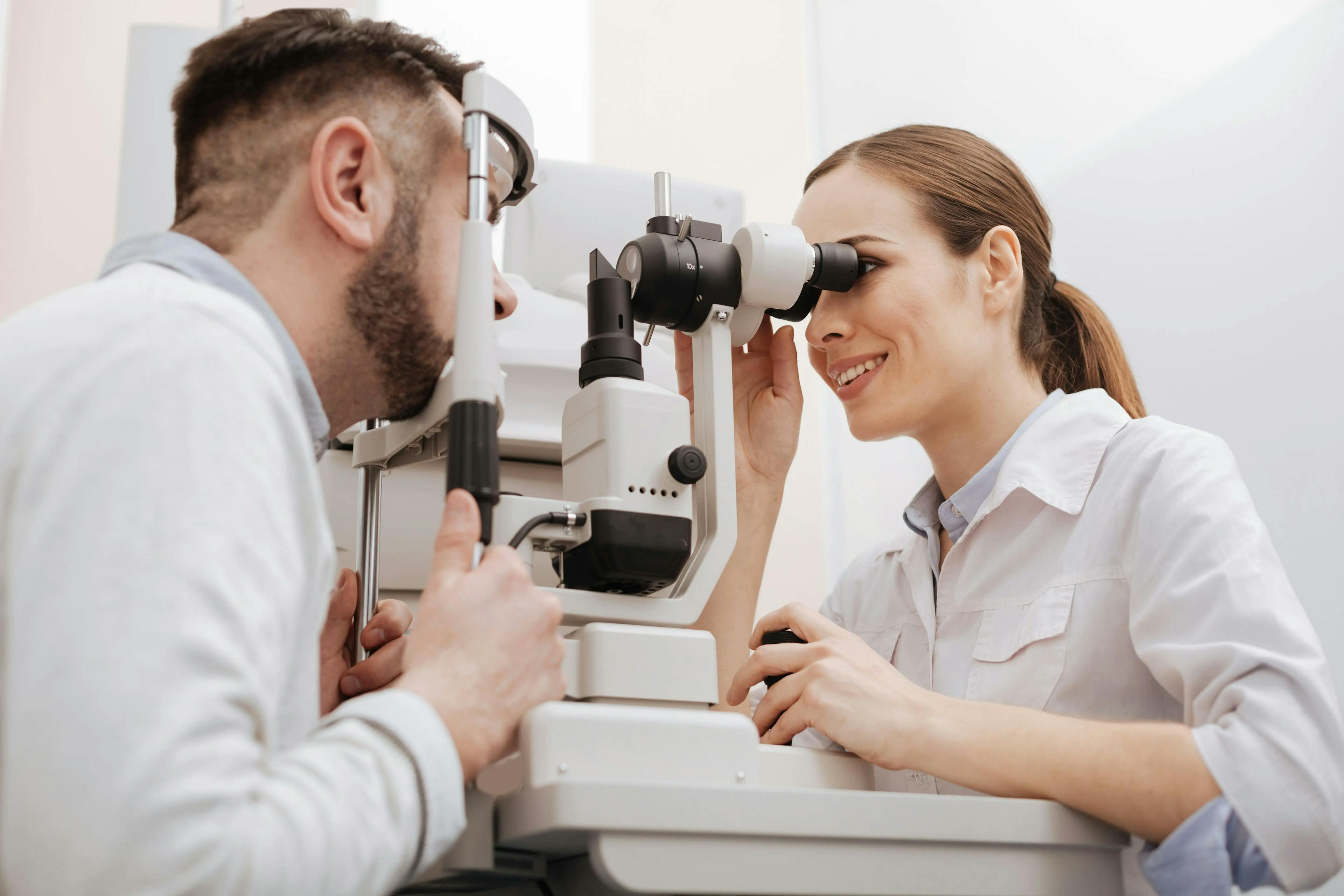
What to Expect During an Eye Exam
During an eye exam, your doctor will discuss various aspects, including any symptoms or concerns you may be experiencing, your current medications, the presence of blurry vision, details about your work environment, and your overall health. Additionally, family history and any past eye or vision conditions will be explored during this phase of the examination. Your doctor will carefully consider this comprehensive information to determine appropriate treatments or provide recommendations tailored to your individual needs.
Vision Testing
Vision Testing
Consistent vision testing and evaluations are essential to maintain the sharpest vision possible. Our optometrists conduct routine vision testing as an integral part of a comprehensive eye examination. Using both an electronic eye chart and a reading eye chart, your doctor assesses how each eye is seeing. The test results are represented as a fraction, with 20/20 as the benchmark for normal distance and reading vision.
Eye Function
Eye Function
Beyond vision testing, we delve into a comprehensive evaluation of eye functionality. Our optometrists perform several tests to evaluate depth perception, color vision, eye muscle capabilities, peripheral vision, and responsiveness to light. Several other tests are completed to determine whether the eyes are focusing, moving, and working together properly. The test results enable our doctors to diagnose any underlying conditions that may be impairing the eyes ability to focus or work together.
Eye Health
Eye Health
As an integral part of our comprehensive eye examination, our optometrists meticulously assess the overall health of your eyes through a visual examination, eye pressure evaluation, and now, the advanced option of fundoscopic photography and optical coherence tomography (OCT). Through meticulous inspection using magnification and bright light, the visual examination identifies any abnormalities in the eyes. Pupil dilation enhances the internal health assessment. Tonometry measures eye pressure, a critical indicator for conditions like glaucoma. Our commitment to advanced eye care includes the innovative use of fundoscopic photography and OCT, that provides detailed retinal images and a three dimensional image of the retinal layers, the inner lining of the eye. These images enable early detection and ongoing monitoring of various eye conditions. Following these evaluations, your dedicated doctor collaborates with you to explore tailored treatment options, ensuring precision and proactive eye care for your sustained visual well-being.
Normal Eye Conditions
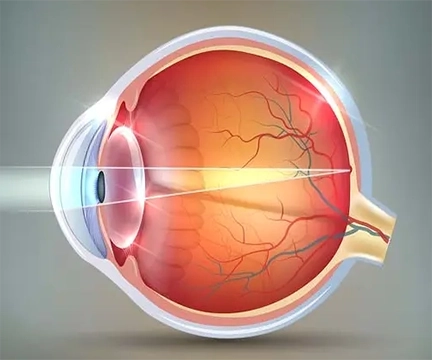
Emmetropia
Emmetropia is the optimal state of vision where your eyes can see both near and distant objects clearly without the need for corrective vision. This occurs when the cornea and lens work seamlessly together, allowing light to focus precisely on the retina, making faraway vision clear. People with emmetropia typically achieve 20/20 vision, meaning they see as well at a distance of 20 feet as a "normal" eye. They do not need glasses for seeing far distances. While emmetropia is the ideal norm, variations can exist, and regular eye exams help ensure any deviations are promptly addressed, contributing to overall eye health and sustained clear vision.
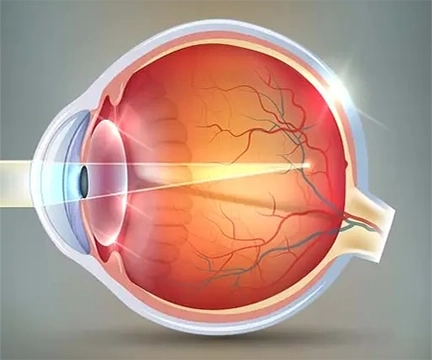
Myopia
Myopia, commonly known as nearsightedness, is a prevalent vision condition that affects the ability to see distant objects clearly. This refractive error occurs when the eye is longer than normal or has a steep cornea, causing light rays to focus in front of the retina rather than directly on it. Consequently, close objects may appear sharp, while distant ones seem blurry. Typically identified in children aged 8 to 12, myopia may progress during the teenage years. While not an eye disease but rather a focusing disorder, myopia often has a hereditary component. It can also affect adults and is commonly managed with glasses or contact lenses.
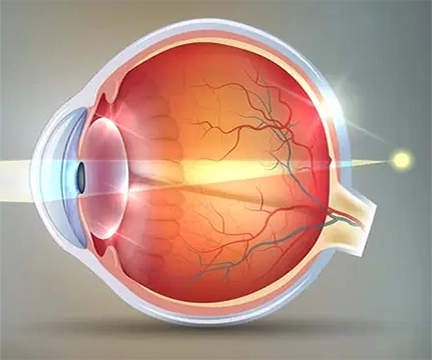
Hyperopia
Hyperopia, or farsightedness, is another common refractive error impacting the clear vision of nearby objects. This condition arises when the eye is shorter than normal or has a flatter cornea, causing light rays to focus behind the retina instead of directly on it. As a result, distant objects may appear clearer than those up close. Hyperopia is often identified in children, and its effects can persist into adulthood. Similar to myopia, hyperopia is not an eye disease but a focusing disorder, and it can have a hereditary component. Common treatments include glasses or contact lenses to enhance visual clarity.
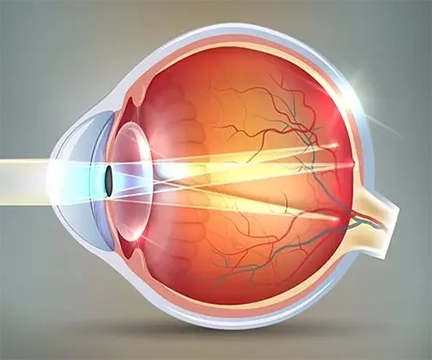
Astigmatism
Astigmatism is a common vision issue that occurs when the cornea or lens of the eye has an irregular shape, causing light to focus unevenly on the retina. This refractive error results in blurred or distorted vision, both at a distance and up close. Astigmatism can often coexist with myopia (nearsightedness) or hyperopia (farsightedness). People with astigmatism may experience difficulties with tasks like reading or driving. This condition is usually present from birth and may change over time. Unlike an eye disease, astigmatism is a focusing disorder, and it can be corrected with glasses or contact lenses designed to compensate for the irregularities in the eye's shape. Regular eye exams help ensure that any changes in astigmatism are addressed, maintaining clear and comfortable vision.
Are Contacts Right For You?
During a contact lens exam and fitting, we can discuss if contacts are the right choice for you. While contacts offer numerous benefits, it's important to acknowledge that they may present challenges for some individuals. Notably, contacts may not be the ideal choice for everyone. Various factors, including eye health, lifestyle, and personal preferences, play a crucial role in determining the suitability of contact lens wear. During the exam, we'll carefully consider these factors to ensure that contacts are right for you.
Contact Lens Advantages
- Enhanced Vision: Contacts provide a wider field of view and eliminate the visual obstructions often associated with glasses.
- Active Lifestyle: Ideal for those with active lifestyles or engaged in sports where glasses may be cumbersome or pose safety concerns.
- Aesthetics: Contacts offer a natural look without altering facial appearance, providing a preferred option for many in terms of aesthetics.
Contact Lens Disadvantages
- Maintenance: Contacts require proper cleaning, storage, and regular replacement, adding a maintenance routine to your daily schedule.
- Comfort Issues: Some individuals may experience discomfort or dryness, particularly if contacts are worn for extended periods.
- Risk of Infection: Incorrect handling, poor hygiene, or extended wear can increase the risk of eye infections, emphasizing the importance of proper care.
Contact lenses are medical devices placed directly on the eyes and require a thorough examination, along with additional tests, to ensure safe and comfortable wear.
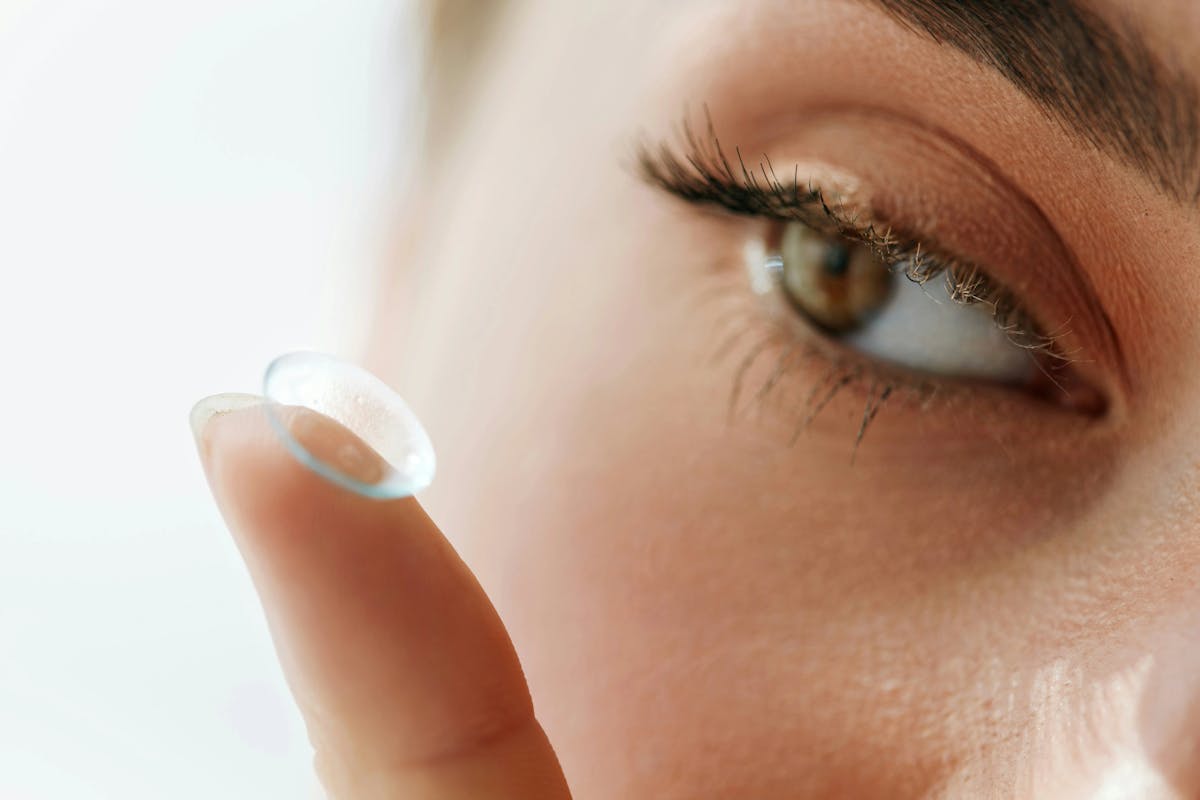
Comprehensive Exam
Prior to prescribing contact lenses, your doctor determines what level of vision correction you require. Refractive error is evaluated by measuring how the eyes focus when a series of different lenses are placed in front of them. An optometrist will use a phoropter to take these measurements.
Contact Fitting
Your contact lens fitting is a crucial aspect of your visit. During the fitting, various measurements are taken to determine the most suitable contact lens fit for your eyes. These measurements include the curvature of your cornea, the shape and surface structure of your eyes, and the assessment of your tear film.
Eye Diseases
To ensure optimal vision and minimize irreversible damage, early detection of eye diseases is crucial. Conditions like glaucoma, macular degeneration, and diabetic retinopathy may not show noticeable symptoms in their initial stages, making regular eye examinations important, especially for specific age groups more susceptible to certain conditions. The risk of developing these conditions is influenced by factors such as your eye health, overall well-being, and family history.
Routine eye examinations serve as a vital tool for identifying potential issues before they advance, allowing for timely intervention and effective management. Proactively caring for your eye health through regular appointments not only improves your vision quality but also plays a key role in the early identification and treatment of any underlying conditions.
Our practice stands out with advanced diagnostic technologies, ensuring a thorough examination. Additionally, our dedicated team offers specialized services and personalized strategies to maintain optimal eye health, tailored to your unique needs and lifestyle factors. We pride ourselves on creating a welcoming environment, prioritizing patient comfort and efficiency throughout the examination process.
Conjunctivitis (Pink Eye)
Conjunctivitis, commonly known as pink eye, is an inflammation of the conjunctiva - the thin, transparent layer covering the white part of the eye and lining the inside of the eyelid. This condition can be caused by viral or bacterial infections, allergies, or irritants. Conjunctivitis often presents with redness, itching, and excessive tearing. Depending on the cause, it may be contagious, emphasizing the importance of proper hygiene to prevent its spread. Identifying the underlying factor and seeking appropriate treatment is crucial for managing conjunctivitis effectively.
Types of Conjunctivitis:
- Viral Conjunctivitis
- Bacterial Conjunctivitis
- Allergic Conjunctivitis
Signs and Symptoms:
- Redness
- Itching
- Tearing
- Discharge
- Light sensitivity
Recognizing the signs, symptoms, and determining the specific type of conjunctivitis are essential for appropriate management and timely treatment. If symptoms persist or worsen, seeking advice from a healthcare professional is recommended
Cataracts
Cataracts are a common age-related eye condition characterized by the clouding of the eye's natural lens, leading to impaired vision. This gradual clouding occurs as proteins in the lens clump together, hindering the passage of light to the retina. Cataracts often develop slowly and may initially go unnoticed, but as they progress, they can significantly impact vision clarity.
Signs and Symptoms:
- Blurred Vision
- Increased Sensitivity to Glare
- Frequent Changes in Corrective Lens Prescriptions
- Faded Colors
- Difficulty Seeing at Night
Risk Factors:
- Age (over 60)
- UV Radiation
- Smoking
- Diabetes
- Hypertension
- Previous Eye Injuries or Surgeries
- Prolonged Use of Corticosteroids
Cataracts can be effectively treated with surgery, where the cloudy lens is replaced with an artificial one. Regular eye exams are essential for early detection and timely intervention. If you experience changes in vision or notice any of the mentioned symptoms, consult with an eye care professional for a comprehensive examination and appropriate management.
Glaucoma
Glaucoma is a group of eye conditions that can damage the optic nerve,often associated with elevated intraocular pressure. This damage can result in gradual and irreversible vision loss. Glaucoma is often referred to as the "silent thief of sight" because it can progress without noticeable symptoms until advanced stages.
Signs and Symptoms:
- Gradual Peripheral Vision Loss
- Blurred Vision
- Halos Around Lights
- Reddening of the Eyes
- Headaches and Eye Pain
Risk Factors:
- Age (over 60)
- Family History
- Race/Ethnicity
- Eye Injuries
- Steroid Use
- Thin Corneas
Early detection through regular eye exams is crucial for managing glaucoma. Treatment options include prescription eye drops, oral medications, laser therapy, or surgery, depending on the type and severity of glaucoma. Since symptoms may not be apparent until later stages, routine eye check-ups are essential, especially for those at higher risk. If you experience any changes in vision or have concerns,consult with an eye care professional promptly.
Diabetic Retinopathy
Diabetic retinopathy is a diabetes-related eye condition that affects the retina, the light-sensitive tissue at the back of the eye. Over time, persistently high blood sugar levels in individuals with diabetes can damage the blood vessels in the retina, leading to vision impairment. Diabetic retinopathy often progresses without early symptoms, emphasizing the importance of regular eye examinations for those with diabetes.
Signs and Symptoms:
- Blurred or Fluctuating Vision
- Floaters
- Impaired Color Vision
- Dark or Empty Areas in Vision
- Difficulty Seeing at Night
Risk Factors:
- Duration of Diabetes
- Poorly Controlled Blood Sugar Levels
- Hypertension
- Ethnicity
- Smoking
Management of diabetic retinopathy involves tight control of blood sugar levels, blood pressure, and cholesterol. Regular eye examinations, often including dilated eye exams, are essential for early detection and intervention. Treatment options may include laser therapy, injections, or surgery, depending on the severity of the condition. Individuals with diabetes should prioritize routine eye check-ups and promptly address any changes in vision to prevent and manage diabetic retinopathy effectively.
Keratoconus
Keratoconus is a progressive eye condition that affects the cornea, the transparent front part of the eye. In individuals with keratoconus, the cornea gradually thins and bulges into a cone shape, leading to distorted vision. This condition typically emerges during the teenage years or early twenties and can affect one or both eyes.
Signs and Symptoms:
- Blurred or Distorted Vision.
- Increased Sensitivity to Bright Light and Glare, Which Can Cause Problems With Night Driving.
- A Need for Frequent Changes in Eyeglass Prescriptions.
- Sudden Worsening or Clouding of Vision.
- Halos and Ghosting
Risk Factors:
- Genetics
- Certain Medical Conditions
- Eye Trauma
Regular eye examinations are crucial for early detection and appropriate management of keratoconus. Individuals experiencing changes in vision or other symptoms should consult with an eye care professional for a comprehensive assessment.
Macular Degeneration
Age-related macular degeneration (AMD) poses a significant threat to vision, impacting millions of individuals. This condition, prevalent in adults aged 50 and above, can lead to severe vision loss. Unlike affecting peripheral vision, AMD specifically targets the macula, a small central region in the retina housing light-sensitive cells that communicate with the brain. The slow breakdown of the macula distinguishes this degenerative process, causing a gradual deterioration of vision. AMD manifests in two main types: wet AMD and dry AMD, each presenting distinct challenges and implications for those affected.
Dry AMD
Dry age-related macular degeneration (AMD) is characterized by the gradual breakdown of the macula, a central area in the retina essential for clear vision. This form of AMD is marked by the accumulation of drusen, small yellow deposits, beneath the macula, leading to a slow deterioration of vision over time. Dry AMD is the most common form of AMD.
Wet AMD
Wet age-related macular degeneration (AMD) is a more advanced and potentially severe form of the condition. It involves the growth of abnormal blood vessels beneath the macula, leading to leakage of fluid and blood into the surrounding tissues. This leakage can result in rapid and significant damage to the macula, causing a sudden decline in central vision. Wet AMD is less common than dry AMD but often requires prompt medical intervention to mitigate its potential for serious vision loss.
Signs & Symptoms:
- Dark, blurry areas in the central vision
- Loss of color vision
- Straight lines that appear wavy
Risk Factors:
- Diet high in saturated fat
- Age (over 50)
- Smoking
- Family history of AMD
- Obesity
- Cardiovascular disease
For those seeking further information, understanding the signs, symptoms, and risk factors associated with AMD is crucial. Regular eye check-ups and a proactive approach to managing risk factors can contribute significantly to preserving vision health. Learn more about AMD and its implications to empower yourself in making informed decisions about eye care.
Did you know that 90% of blindness caused by diabetes is preventable? Take control of your eye health by scheduling regular comprehensive eye exams. Detecting diseases before symptoms arise is crucial, and early diagnosis can prevent vision loss. Book your appointment today.